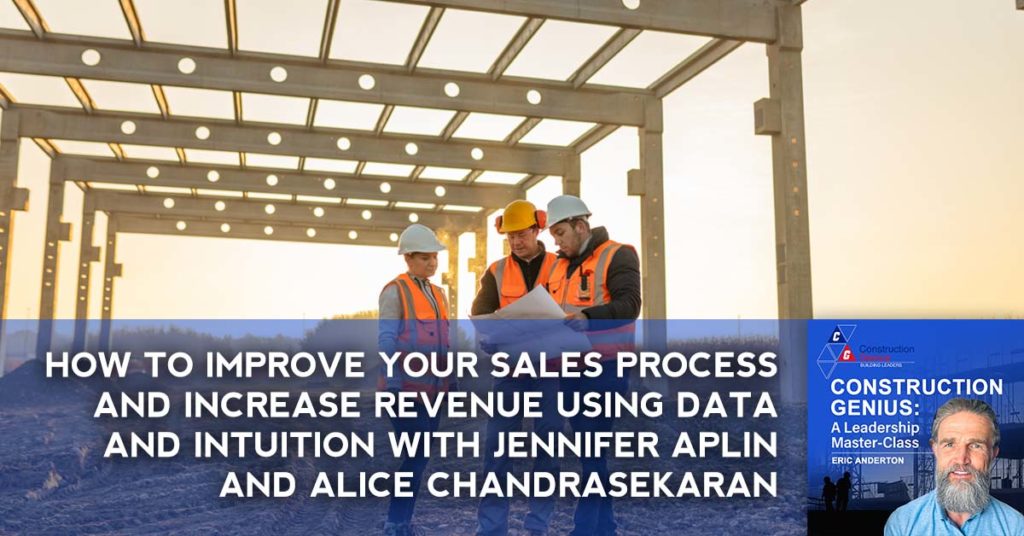Every company follows a different sales process to build revenue. But some organizations don’t want to keep an open mind. You can’t scale if you don’t want to do things differently. Learn what drives your revenue and how you can plug out all the leaks. Join Eric Anderton as he talks to Jennifer Aplin and Alice Chandrasekaran of Digital Magenta about increasing your revenue with data and intuition. Jennifer is the CEO and Co-Founder of the company, while Alice is the Co-Founder and Chief Intelligence Officer. Discover your key meetings, which can lead you to more revenue. Do things differently to scale and grow. Scaling doesn’t always mean adding more salespeople. It’s more about improving your sales process, data gathering, and systems. Start optimizing your sales process today!
—
Watch the episode here
Listen to the podcast here
How To Improve Your Sales Process And Increase Revenue Using Data And Intuition With Jennifer Aplin And Alice Chandrasekaran
What’s your hit rate or your win rate? What’s your average deal size? How long does it take you to land a new project from initial contact to a signed contract? What are the key meetings that help you to get to revenue, to that signed contract? All of these questions are vital for you to be able to answer clearly if you are going to be able to drive revenue successfully. That is the topic of conversation with my guest, Alice Chandrasekaran, and Jennifer Aplin, the Cofounders of Digital Magenta.
Digital Magenta is focused on helping you to get clarity on your sales processes, meet and exceed your revenue targets, capture top performer intuition and your unique revenue drivers, and then take action on your key revenue. This conversation is going to be tremendously insightful for you when it comes to sales. The good news is Jennifer, Alice, and myself have decades of experience in sales and working complex deals in competitive environments. That’s exactly the environment you are in as a construction company.
I would like you to pay close attention to the specific insights that Alice and Jennifer share. You are going to find them incredibly helpful. If this interview is something that you would like to know more of, let me know. Sales is one of my passions. I want to help you get better at selling projects to the right clients in the right locations. If you would like more interviews and data around this type of topic, let me know. Go to my website, ConstructionGenius.com/contact and say, “Eric, I want more of this.” Anyway, enjoy my conversation with Alice and Jennifer. Share it with other people. Thank you for tuning in to the show.
—
Jennifer, Alice, welcome to the show.
Thanks for having us, Eric.
Thank you.
I am deeply interested in sales processes. It’s something that has had a tremendous positive impact on my life, learning sales processes and figuring out how to fix them. You guys do a lot of work around sales processes. I want to lay some foundations here as we begin our conversation. What do you mean by a sales process?
When we look at the sales process, we take a cross-functional view across all the steps that it takes for a company to attract and bring on new business, close new business, and retain the business they have. We are looking at the set of activities, starting on the marketing side to when an opportunity comes in. How does the sales team act on that opportunity in the most effective way to get that deal to a close and beyond, and also manage that relationship with that new client throughout the course of their time together?
In your minds then, a sales process encompasses almost every aspect of the business, from the first time a customer becomes aware of your company all the way through to their interactions with you on an ongoing basis?
It’s all the steps that a company has to take to drive revenue. It starts before a salesperson gets a lead in their inbox. It lasts long after in terms of, “How do we manage this relationship effectively? How do we make sure this is a customer for life?” We are servicing our customers in the best possible way we can.
That’s interesting because if you take that approach, as you are describing it, then we are always selling.
Everyone is in sales.
Why is it important to identify those steps and have a sales process in place that you are conscious of and trying to execute?
As companies grow, they start building the layers. Their teams are growing. They are building various processes across the company. Some of their teams may be dispersed, especially with the shift to remote workforces. It’s important to identify what the repeatable steps are that a sales team can take, especially as it grows.
As companies start adding new team members, it's important that there's agreement and alignment on how they drive revenue. Click To TweetTypically, we see that there are few top performers on a sales team. What if we could capture all of the steps that that person is taking and make that scalable across the whole team? As companies start adding team members, especially in the sales function, it’s important that there’s an agreement in alignment around, “How do we drive revenue in this organization?”
It’s interesting because when you are selling something, there are functional things that you do. You fill that function with your own personality and uniqueness. How do you distinguish between a process step and then something which is something you do? You don’t know how you do it. You don’t know why you do it. You just do it and it produces some success.
We see that a lot. There is a data-informed answer to that question. There are also things that we do in selling that are coming from our gut feel and coming from understanding our customers. These are two separate things. When it comes to the softer side of sales, it is all about understanding, “I am here to serve this person. What do they need from me?” Those items can also be captured and can be repeatable for the company.
To add to that, to give a tangible example of what Jennifer mentioned it’s, “What is your best performer doing, and what needs to be translated to the rest of the team?” A tangible example that we commonly find, the best performers are extremely good at follow-up. This is consistent across the different companies. They are always telling us, “I immediately pick up the phone and I do this and that.”
We look across the team and say, “Your best performers are doing this. Maybe this needs to be across the team that you have a phone or email follow-up within this timeframe because this is your best performers’ behavior.” This is one theme that has consistently emerged for us when we work with our clients, to give a tangible example.
That’s an excellent example because when some people approach selling, they do think that, “Some people are born to sell. I can’t be like that person.” That’s the mindset that often comes in. What you said there, Alice is that those practical things that we can all do, if we are able to discipline ourselves, those can then be translated into our sales process. Let me ask you this. You guys do a lot of work on going into companies that have preexisting sales processes. Where do you find the most common bottlenecks in a sales process?
When we work with clients, we are looking across all of the revenue-generating processes. There are five key places that we find bottlenecks. We also call those revenue leaks because that’s how they are showing up in the business. Number one, it’s not having the right focus. We are investing in growth activities. Maybe we are going to trade shows or doing online campaigns. We don’t know the ROI of those programs.
At the end of the day, we don’t understand how those are affecting revenue. We are seeing a lot of manual processes popping up that were probably generated in the early stage of the company. Those manual processes are not going to get the company where they need to go into their next phase of growth. We are looking at where we can remove some of that friction in terms of the manual process.
As the company grows, we are also seeing individual functions optimized with technology. That also creates a lot of bottlenecks across the process. We want to make sure that the technology we are using across the growth function between marketing and sales is connected and data can flow across those systems.
The last one that we see is data that is being used to make growth decisions that may not be accurate and timely. We are using this data to make important decisions. We see that sometimes there’s too much data. We can’t derive insight from it. Sometimes there’s too little data. Sometimes data isn’t accurate. How are we using that data to make decisions around how to grow the company?
You mentioned not knowing the ROI of these programs. In other words, we are throwing stuff up against the wall and hoping for the best. We are running around, imitating what other people are doing because that’s what we think is going to help to land a deal or a project. In your experience, what do the best companies do when they are putting these measurements in place to get something from those activities that they are doing and understand what’s working?

There are two key things when we look at ROI. We call it as, “What is the goal of this activity that you are doing, and what is the result?” It is always good to take a step back and say, “Is this activity to drive awareness?” Awareness always generates results in terms of revenue but equates it, so you set the right expectation. Sometimes companies go to events to meet with their existing partners to network.
In that scenario, it is an investment to continue your current customer base and maintain a relationship. It’s always important to take one step back and say, “What is our goal? What is the expectation in terms of result? Can we answer that question instead of manually pulling all the data pieces together?” When you have the right foundation, you should be able to answer those questions.
That’s excellent because sometimes we try stuff and get frustrated because it didn’t work. In our minds, work means, “I didn’t go to that event and get a project opportunity.” The reason why is because that was never going to happen in the first place anyway. You should have set your expectations correctly in terms of, as you well described their developing relationships or whatever the case may be. In sales, that’s one of the big mistakes that we make. We think that if I do this one activity, it will directly lead to a sale. We know that is not the case if we step back and think about it a little bit.
What we are doing is going to impact the business in the future. That’s another important point. We also see that we meet a person at an event that may become a customer but they are not ready to become a customer yet. They are ready to become a customer in 6 or 8 months. How do we manage and maintain connection and relationship? How do we know when that person is ready to engage with us?
Let’s talk about that. How do we know when that person is ready to engage with us?
When you have the right foundation, especially for the construction industry modernization, we talked about the manual process being a leak. This is where you can modernize to say, “Are they interacting with our content?” It is unique for each business. It is important to understand, “What content are they engaging? At what point are they ready? At what point are they ready to engage?”
If you look at the landscape, 60% to 70% of the buying process, the individual has already done it. They are already on Google. They are on your website. They have observed you on LinkedIn. They have gathered a lot of information before picking up the phone and talking to you. In a lot of cases, we see in that process when the right time is to intercept and say, “Do you have questions that I can help you answer?”
For that, you need to understand the important points of interaction that eventually qualify them as, “This person is ready to interact but they are in their process of investigation and decision making.” Modernization allows you to do that in a lot of situations. This is where it will be difficult if it is up to the salesperson to keep up with every single person on, “They are doing this.” This is where we find that when the right systems are in place, it builds that competitive advantage for that company.
By modernization, what you mean is having systems in place using technology that alert me to when a person has looked at a piece of content or when they have gone to a certain part of my website. Is that what you are referring to?
Yes. Typically, a lot of technologies allow you to do that. They visited your blog or website but where the clarity needs to happen is, “What content and series of content that they have engaged in? At what point do I engage?” It’s either people are, “That person is engaging. Are they engaged too soon,” or do they wait for that person to reach out to them?
It is important to understand when in their journey you should reach out. It’s unique. For some companies, the person is looking at the product specs and checking out pricing. This is a good place for us to ask and reach out, “Do you have any questions stands that I can help you with?” It is unique for each company because not every company does product and services.
When you have the right systems in place, you'll always have a leg up in the competition. Click To TweetYou have to do some hard work to understand how your clients engage with you as they decide whether to do business with you.
It is a game-changer for companies when you get that level of clarity.
How do I go about getting that level of clarity?
This is the hard work and part of the sales process. When you understand what steps your sales team is taking to get to a revenue closing, when you have this lead or prospect that has been on your content and researching about you, the first step is also getting clarity on, “In this part of the process, when they have visited X, Y, Z, and consumed our content and interacted, I should reach out.” That becomes a sales process at the end of the day.
What you said here is so critical. People have done 60% to 70% of the work before they even contact you. If your content and upfront marketing is doing their job, when people are in touch with you, then there’s a comfort level with your company which should help to facilitate improving your sales results. Is that correct?
Absolutely. This is all about understanding your customer and their needs. What do they need to consume? What answers do they need to have before they are ready to talk to you?
In the best interactions between someone who is selling and a potential client, the salesperson understands the pains and the desires that each client experiences. They are able to tailor their presentation to alleviate the pain and also meet the desires that they have. I would like to talk about data a little bit more.
You talked a lot about data that is either inaccurate or overwhelming. One of the things that cause people to be reluctant about engaging with technology is that it does produce all of this data. What if I don’t understand the data and I don’t know where to look in the data to find what’s actionable? Can you talk about that a little bit, please?
When we talk about data, we talk about data that drive revenue in your organization. We look at it as four key revenue levers. There’s a lot of data. Technologies produce so much data. We are all data overwhelmed but the analogy I’m going to use is that we all probably use 1% of our brain and are pretty powerful with just that. The revenue levers do that. In our perspective, the four important ones are the win rate, average deal size, the average time to close, and then the key meetings that get you to revenue.
Win rate in construction, that would be like hit rate. The win rate is good, though, too. That’s nice and clear. Average deal size, I get that. Time to close and then the key meeting.
The key meetings help you to get to revenue. It could be 1, 2 or 3 important meetings that get you to revenue. For example, for one client, it was a site visit. There was a complimentary site visit. That’s how they started. It’s what starts that revenue generation process and brings it down to, “What are the meetings we should be doing now to get us to closing in 3 months, 6 months or a year from now?”

You talk about key meetings. How do I know which meetings? Sometimes maybe I close a deal and I have two meetings. Someone says, “Eric, I want you to build this project for me. This is what the project is. This is the amount and we are going to go here in October. Can you do it?” In other situations, we’ve got to dance and then dine for a little bit, and all that stuff. When you say key meetings, how many key meetings do I need to have?
There’s a formula behind it, which is why we talked about the average deal size. We talked about the win rate, which is, “How many customers do you need at the end of the day?” There’s a formula with all these levers put together and then you do the time to close. To give you an example, they needed to do at least two scoping meetings per month to hit their revenue target, considering their win rate and deal size but it all started with a scoping meeting.
It’s interesting because people reading may be looking at their backlog of projects and they are like, “I need to get some stuff in the door if I’m going to keep my people busy.” It’s so interesting that you talked about the hope and the possibility that I can identify specific actions. If I discipline myself to take those actions consistently, I can then expect a result.
This is the difference between a KPI and a leading indicator. They might be measuring their teams on total meetings but that doesn’t tell us anything. Getting down to Alice’s example, that was a leading indicator that she was able to uncover in that specific company’s process. We know exactly what to measure. Companies can then shift to measure what matters, moving from maybe what’s more of a vanity KPI to a metric that is moving the business forward.
We must stop here and explore this. Tell me the difference between a key performance indicator and a leading indicator.
A KPI can both be a leading and a lagging indicator at the end of the day. An easy example is a forecast. Forecast is a leading indicator. You are able to forecast your revenue. If your forecasting is done properly, you will know if you are going to reach your revenue goals this year or not. Whereas a win rate is a KPI that you are just monitoring. It’s still a KPI. You could go, “I didn’t hit my goals this year. My win rate was only 30%.” It doesn’t move things in the future if you are not moving it with the forecast.
In your formula where you had those four-key revenue drivers, would it be correct to say that your key meetings are leading indicators, whereas your win rate is that lagging indicator?
It is a KPI. I would call the win rate a standard KPI. It shows what’s happening. It’s not predicting the future for you. You have to say, “For me to close $100,000 and work the same pipeline, I might have to increase my win rate from 30% to 50% to reach it.” You have to move it whereas the meetings, let’s say you set it to, “I am going to do two meetings every month,” and you didn’t hit the two meetings in February, for example. It shows you are not going to hit your revenue. That’s a leading indicator.
This is vital because there are these vanity metrics. Even a lagging indicator is useful because they tell me what’s happened in the past but the leading indicator will tell me what’s happening in the future. It’s so vital that everyone is able to clearly identify that. If I’m able to identify those four things, then I should be able to capture those four things. How do I go about capturing them specifically? Tell me about that.
There is a set of processes that we go through in identifying what those key meetings are for the client. It is unique to each business and construction business. They all have their uniqueness, especially in the construction industry. What we do as step one understands all the steps and actions their sales team is taking to get to revenue.
We start zoning back into, “Every time you do this meeting, this is the origin.” This is another key turning point in that process. We zone into those two meetings and start working backward to revenue goals. That’s how we identify the key meetings. It is important to sit down, take a minute, and understand the steps your sales team is taking. What are those consistent steps? Coming back to it to say, “Every time we do this, at the end of the day, based on the win rate, there’s potentially a deal.”
In sales, customers have already done 60 to 70% of the work before they even contact you. Click To TweetI work with a number of mechanical contractors and in many cases, they have three revenue streams where you have ground-up construction, you have special projects, which are smaller projects, and then you have service. Those are 3 unique businesses within 1 business. Each bucket needs its own sales process, data, and indicators.
The one common thing we see in construction industries is there is typically a rep that sometimes functions across three areas. It’s not clearly called out. They are navigating it. Whereas when you clearly call out, these are three separate areas, the actions you take here versus the second area are completely different. It is important to call that out. When you call it out and you start tracking it, it makes a world of difference.
I can imagine those unicorns that people have in the smaller company where they are selling all three of those in the mechanical contractors. It’s crazy but it’s important to be able to get from them what they are doing so that you can begin to build your sales processes if you want to grow your business.
You don’t want to be caught in a situation where that person leaves. You don’t have it captured in any type of model. How are you going to bring on the next person? We are going to have to go through that whole learning curve again. That person is going to have to come in and figure out that set of activities and steps.
What we are talking about here is not only about me, landing work but also about a succession planning piece. A lot of construction companies’ key executives and the owners of the company are driving revenue through their relationships. If they want to be able to pass that company on to the next generation and scale the company, they have to be going through this process of rationalizing their sales activities.
They need to start doing that. From our experience, we have seen executives in the industry feeling they have left it a little bit too long. How do we get ahead? That’s where we come in to help guide them on all of the steps that they need to take to do this. They don’t have to go through trial and error because it can take years if you are setting out alone without a partner to provide that guidance and that expertise.
When it comes to the company that has a complex sales process selling a large construction project, let’s say you are selling a $10 million, $15 million, $20 million, $30 million, $100 million projects, that’s an incredibly complex sale. How long does it take you guys to help people to establish those sales processes begin to get their arms around what they are doing so that they can do it better?
When we begin to engage with a client, we are going to spend a couple of months working through where you are at. Everyone is starting from a different place, so we are looking at their business, their business model, how revenue flows through their organization, and where the bottlenecks are happening. We are going to layout a tailored plan to say, “You were here. Maybe you want to double your revenue over the next few years. What are the things that we are going to need to do methodically to get you from where you are to where you need to be?”
There are a lot of companies that have grown to $50 million, $75 million but they want to go bigger. They want to scale into that $100 million, $250 million-plus. They know what got them to their level of growth is not going to get them to that next phase. That’s typically a characteristic of an executive team that we would work with. They understand that we need to do things differently. We would like to bring in an expert to help us do that because we need to get to this next phase.
You work with folks around unique revenue drivers. I would like to explore that a little bit. What do you mean by a unique revenue driver? What is that?
When we talked about the revenue levers and within the revenue levers, we talked about the meetings. The meetings are the unique revenue drivers. Per company and service category, it’s different. It’s understanding and getting to the bottom of, “What is that driver for your business.” When we say unique revenue drivers, it’s not just the origin point. We are also looking at, “How do you retain customers? How do you renew customers? What is the origin point for that?”

Construction is so fascinating because I land a project. I ink a project. Let’s say I’m going to be working on it for six months to a year. I’m selling throughout the whole time that I’m building the project. I may have an ongoing relationship from a service perspective or another opportunity with that same client to build a different project. Tell me a little bit about the types of meetings I should be having as I’m going through the process of building a project and even wanting to cultivate that long-term relationship.
We see a flavor here, depending on the company. Every company has its own flavor that they bring in. One company that we work with, their flavor is they do regular golf tournaments with their clients. Another flavor we have seen is check-ins. This company is also construction. They are systematic to the point that they have their people check in with their customers and get some surveys going on to say, “Are they happy? Are they not happy? What do we need to do to navigate to make the relationship is on the right track?”
It’s interesting because when you are building a project, you have direct contact through, let’s say, you are project managers, superintendents, or foreman with the clients or with your project partners. In that contact, there are often a lot of conflicts, challenges, and difficulties. Every construction project has it. Is it useful to bring in someone from your company who’s not directly involved in the day-to-day project to interact with a client a little bit and provide a buffer there? Should you stick with the folks who are on the front line? What have you seen there?
We have seen the executive and leadership team have a presence in that relationship. It doesn’t have to be one-on-one is our experience in companies that can manage. There are clients that service multimillion-dollar deals. You service that relationship differently. We talked about modernization. How do you service all your clients similarly? How do you get all their pulses? There is a number of people that are in the front end doing their job. It could be general contractors, a foreman, project coordinators or project managers. They go down the list.
What we have seen is a survey. It has to be timed properly. You have to understand when you get a survey out to check the temperature in that project’s timeline. It gives the leadership team good visibility into, “Do we need to do something differently here?” Typically, people fill out surveys when there’s bad news or when there’s exceptionally good news. What we have seen is when it’s going okay, people are fine. When there’s something that they are disgruntled about, they will let you know. They take it as an opportunity to let you know.
Those revenue drivers are the key meetings. That’s a great insight. I would say to anyone reading here one of the key takeaways that you should put on your list is to sit down and identify those key meetings that lead to revenue. Get together with your top salespeople and figure out what you are doing in those key meetings and then how you are going to communicate that and teach that to other people to get some replication, even if it’s only 80% to 90% of what your superstars are doing.
It gives your team an equal playing field. You created a better playing field for your team rather than a person running 50 yards ahead of you.
We have had clients describe it as everyone is playing with the same deck of cards.
For one, it gives confidence to people that if I do this, then this will happen. It also removes excuses from people because oftentimes, we are thinking, “That’s her. She’s a baller. She knows how to close business.” That removes my excuse in the sense that, “I may not be quite like her in terms of her ability to win business but I can surely do 80% of what she’s doing and then be successful.”
That idea of relying on her is not scalable.
If you are looking to scale, you have to do something other than, “She’s my unicorn. Let her go out and kick some butt.” We have to be able to do something different than that.
It's important to just sit down, take a minute, and understand the consistent steps your sales team is taking. Click To TweetWe have to be able to capture it in some type of a scalable model, so new team members can easily be onboarded, even as the company grows. We hear a lot of companies say, “The way we’ve got to $20 million, $30 million is we hired new sales reps.” We will just go out and hire new sales reps. It will take a new sales rep $100,000, $150,000, and seven-plus months to onboard appropriately. Do you need more sales reps or do you need to get clarity on the activities that your existing sales reps need to take?
In that way, your sales reps can be working more efficiently and smarter and, therefore, produce more revenue.
You can potentially be growing your revenue significantly without adding resources.
If I can grow revenue without adding overhead, that’s awesome. Let’s go on to this idea of achievable revenue targets. What do you mean by an achievable revenue target?
We see different behaviors here. One of the common behaviors we see is, “We reached $40 million this year. We want to get to $80 million.” Typically, they shoot and say, “I’m going to add a couple more salespeople and we are going to shoot for $80 million.” There’s a level of detail that has to be looked upon to set achievable targets.
The difference between an achievable target is you have worked backward than relying on your players. We talked about you having a unicorn player and I need to bring another unicorn player. How would you know if that player is a unicorn player or not? You can’t. Only time will tell. The fact that you have clarity on your revenue drivers, and then you start working backward, “My win rate is 50%. I need to close four clients. I need to be working at least eight. Does my team have the capacity to handle those eight prospects?” They probably do. In a lot of cases, what we find is their team has capacity if you focus them properly.
That’s a tremendous insight there because what will happen is you will hire your salesperson. You will go back to your real job of building projects and hope for the best. Months later, “This guy sucks. He didn’t reduce any project. I have to go get another person.” Instead, what you described is so key. If you do this, then this will happen. Therefore, I’m going to hold you accountable for these activities.
It gives the managers a way to coach their team and takes the emotion out of it. We are using data to clearly communicate the expectation.
A key insight here is that if you want to grow revenue, it’s not necessarily by adding more salespeople. It’s by improving your sales processes, the data you are getting, and understanding what you need to do to get those revenue-generating events going. That’s excellent. I appreciate your guys’ insights here. Alice, Jennifer, can you tell us a little bit more about Digital Magenta? What is it that you do?
We are a revenue growth consultancy. We work with our clients to help them maximize and optimize their revenue. We do that by looking at where the leaks are showing up. Let’s plug the leaks and get clarity on what’s driving the business forward so we can organize people and systems around those things.
How can people get in touch with you?

They can look us up on LinkedIn. I’m the only Jennifer Aplin on LinkedIn and Jennifer Aplin on Digital Magenta. You can also send me an email at [email protected].
Let’s say I run a construction company and want to grow revenue. Feel free to summarize what you have already said. What are three action items you would recommend a construction company owner do to begin that journey to improving revenue and landing the right projects with the right people?
Number one, ask yourself, “Do I have a growth mindset?” Having a growth mindset means that we are open to looking at things differently and what is going right in the organization. Where are things falling down? The second thing that I would say is looking honestly at the business. The third thing is, “Do I need help to get from where I am to where I want to go?” If the answer to that question is yes, then we would gladly have a conversation and provide any advice we can on what they might want to be thinking about or looking at.
On the help part, you know you need help when you have a sense that things should be different and you want them to be different but because you are so busy doing other things, you don’t have the time to give sufficient energy and focus on that particular item that you know you need help with. This has been awesome. Alice, Jennifer, I love talking about sales, so I’m pleased that you guys came to the show. I have one last question here. You are in Calgary. Let’s say I’m up in Calgary for a business meeting. I’ve got a couple of days. I’ve got a free night. What’s the best restaurant I need to hit?
If you like Italian, I’m going to go with Mercato. It’s on 4th Street. It is the best Italian I have ever had, including inside of Italy.
Guys, I appreciate your time. This was super awesome. Thank you for joining me. I do wish you all the success with your business.
Thank you very much, Eric.
Thank you for having us. It’s great talking to you.
It was a great conversation.
Important Links
- Digital Magenta
- ConstructionGenius.com/contact
- LinkedIn – Jennifer Aplin
- [email protected]
- Mercato
- https://www.LinkedIn.com/in/alice-chandrasekaran/
About Jennifer Aplin
My business partner and I saw an opportunity to help companies navigate this complexity and set out on our journey in 2016 to build a Growth Data™ Framework to help B2B companies scale without these leaks – – and find innovative ways to grow revenue. We combined our expertise in growth strategy, process optimization, engineering and analytics and built a proven consulting framework to help you maximize your revenue potential.




